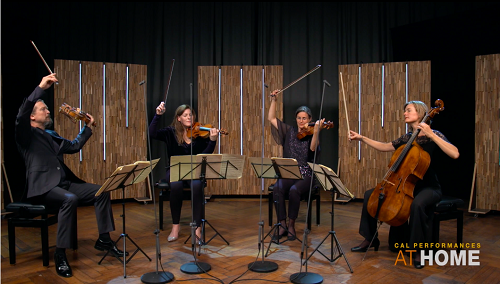 United States Beethoven: Tetzlaff Quartet (Christian Tetzlaff, Elisabeth Kufferath [violins], Hanna Weinmaster [viola], Tanja Tetzlaff [cello]). Recorded at b-sharp studio, Berlin, for Cal Performances, and available on demand through 6 January, 8.10.2020. (HS)
United States Beethoven: Tetzlaff Quartet (Christian Tetzlaff, Elisabeth Kufferath [violins], Hanna Weinmaster [viola], Tanja Tetzlaff [cello]). Recorded at b-sharp studio, Berlin, for Cal Performances, and available on demand through 6 January, 8.10.2020. (HS)

Beethoven – String Quartet in B-flat major Op.130; Grosse Fuge in B-flat major Op.133; String Quartet in A minor Op.132
Any serious string quartet approaches the late quartets of Beethoven as a challenge. The task is to find some aspect or aspects that all the serious string quartets that preceded them playing these masterworks may have missed. But rather than try to find something new to say, the Tetzlaff Quartet seems to have decided to let the music simply speak for itself.
This concert was recorded for Cal Performances, which is presenting a virtual season this year instead of its usual series of live concerts at the University of California, Berkeley. German violinist Christian Tetzlaff and his associates light-footed it through the Quartet in B-flat major and its partner, the Grosse Fuge Op.133, and delivered the final Quartet in A minor with more amiability than heat.
They focused their formidable technical abilities and musical sensitivities on a decidedly conservative framework. With careful attention to intonation and laudable unanimity of articulation, they faithfully observed Beethoven’s tempos and dynamics. Missing, to these ears, was intensity. Aiming for beautiful sound, they smoothed out what could have been dramatic contrasts and softened what might have been lively rhythms. In both quartets they let the slow movements, among Beethoven’s most sublime, flow with unaccustomed gentility.
Op.130 began the program with a first movement Adagio and Allegro that never quite revved up, and a Presto that fell short on crispness. The Andante hummed with sweetness, and the dance that followed came off as stately rather than rambunctious. The highlight of this run-through, however, was the lovely cavatina, in which second violin Elisabeth Kufferath made the tune sing gracefully. The melody passed smoothly from Tanja Tetzlaff’s cello to Hanna Weinmaster’s viola before Christian Tetzlaff brought it to a subtle close. A sober reading of the final Adagio completed the quartet.
Only a short pause separated this from the fugue, which they played with care and precision and just enough energy.
The Op.132 quartet started off with a similar mid-level of energy in the opening movements before arriving at the expansive Molto Adagio, a set of variations on what Beethoven called a ‘holy song of thanksgiving from an invalid to the Divinity’. The players chose to apply vibrato sparingly, thus creating a glassy sound that, thanks to their technique, maintained intonation and presence throughout. If the contrasts were less dramatic than what we usually encounter in this music, the through-line was beautifully wrought, and the final pages brought the movement to a breathtaking close.
The march and Allegro appassionato, a bit too polite to achieve a rousing finish, did not erase the effect of that Molto Adagio, which lingered in the ears and stood as a highlight of the hour-and-a-half concert.
The video, shot in mid-September at b-sharp studio in Berlin, places the quartet against a background of polished wood plaques that feature metallic vertical slashes of various lengths. With several cameras providing a range of angles, director George Kleinegees favored close-ups of the individual musicians, and the sound was rich and clean.
Harvey Steiman
The performance is available for viewing on demand until 6th January by clicking here.